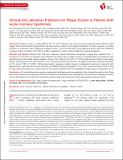Clinical and Laboratory Predictors for Plaque Erosion in Patients With Acute Coronary Syndromes
Author(s)
Yamamoto, Erika; Yonetsu, Taishi; Kakuta, Tsunekazu; Soeda, Tsunenari; Saito, Yoshihiko; Yan, Bryan P.; Kurihara, Osamu; Takano, Masamichi; Niccoli, Giampaolo; Higuma, Takumi; Kimura, Shigeki; Minami, Yoshiyasu; Ako, Junya; Adriaenssens, Tom; Boeder, Niklas F.; Nef, Holger M.; Fracassi, Francesco; Sugiyama, Tomoyo; Lee, Hang; Crea, Filippo; Kimura, Takeshi; Fujimoto, James G; Fuster, Valentin; Jang, Ik‐Kyung; ... Show more Show less
DownloadPublished version (941.1Kb)
Publisher with Creative Commons License
Publisher with Creative Commons License
Creative Commons Attribution
Terms of use
Metadata
Show full item recordAbstract
Background: Plaque erosion is responsible for 25% to 40% of patients with acute coronary syndromes (ACS). Recent studies suggest that anti-thrombotic therapy without stenting may be an option for this subset of patients. Currently, however, an invasive procedure is required to make a diagnosis of plaque erosion. The aim of this study was to identify clinical or laboratory predictors of plaque erosion in patients with ACS to enable a diagnosis of erosion without additional invasive procedures. Methods and Results: Patients with ACS who underwent optical coherence tomography imaging were selected from 11 institutions in 6 countries. The patients were classified into plaque rupture, plaque erosion, or calcified plaque, and predictors were identified using multivariable logistic modeling. Among 1241 patients with ACS, 477 (38.4%) patients were found to have plaque erosion. Plaque erosion was more frequent in non–ST-segment elevation-ACS than in ST-segment–elevation myocardial infarction (47.9% versus 29.8%, P=0.0002). Multivariable logistic regression models showed 5 independent parameters associated with plaque erosion: age <68 years, anterior ischemia, no diabetes mellitus, hemoglobin >15.0 g/dL, and normal renal function. When all 5 parameters are present in a patient with non–ST-segment elevation-ACS, the probability of plaque erosion increased to 73.1%. Conclusions: Clinical and laboratory parameters associated with plaque erosion are explored in this retrospective registry study. These parameters may be useful to identify the subset of ACS patients with plaque erosion and guide them to conservative management without invasive procedures. The results of this exploratory analysis need to be confirmed in large scale prospective clinical studies. Clinical Trial Registration: URL: http://www.clinicaltrials.gov. Unique identifier: NCT03479723.
Date issued
2019-11Department
Massachusetts Institute of Technology. Research Laboratory of Electronics; Massachusetts Institute of Technology. Department of Electrical Engineering and Computer ScienceJournal
Journal of the American Heart Association
Publisher
Ovid Technologies (Wolters Kluwer Health)
Citation
Yamamoto, Erika et al. "Clinical and Laboratory Predictors for Plaque Erosion in Patients With Acute Coronary Syndromes." Journal of the American Heart Association 8, 21 (November 2019): dx.doi.org/10.1161/jaha.119.012322 © 2019 The Authors
Version: Final published version
ISSN
2047-9980